Purpose
The purpose of this activity is to support students classifying shapes by their properties.
Achievement Objectives
GM2-3: Sort objects by their spatial features, with justification.
GM2-4: Identify and describe the plane shapes found in objects.
Required Resource Materials
- Copymaster
- Loops of rope, twine, or wool.
- Cards to label the diagrams
- Marker pen
Activity
- Make the following Venn diagram with loops of rope, twine, or wool on the floor or tabletop.
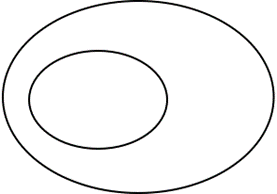
I made these spaces to show that whatever shapes are in here (trace around small ellipse) also belong in here (trace around large ellipse).
- Place one square and one rectangle from the Copymaster in the Venn diagram as shown below:
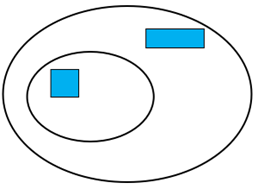
Talk to your partner about this diagram. How can a square also be a rectangle?
- After a suitable time gather the group to discuss their ideas. Look for students to make statements about the properties of the two shapes. Examples might be:
- Both shapes have four sides.
- Both shapes have L shaped (right-angled) corners.
- The rectangle has two long sides and two short sides.
- The square has four equal sides.
- Look up the definition of a rectangle using an online mathematics dictionary. The definition should be:
“A four-sided polygon that has four right angles.”
Tell students that a polygon is a flat (2-D) shape that is enclosed by sides.
Does a square have four sides and four right-angles?
Introduce relevant te reo Māori kupu throughout discussion (e.g. tapawhā rite - square, tapawhā hāngai - oblong/rectangle, taparau - polygon).
- Use cards to name the rings in the Venn Diagram as “rectangles” and “squares”. On the back of each card write the defining properties.
Rectangle: 4 sides, 4 right angles
What shall we write on the back of the “squares” card?
The important point is that the criteria for rectangles apply to squares with one extra requirement; all four sides are equal (in length).
- Put the other quadrilateral cards from the copymaster on the floor or tabletop.
Choose a shape from the set and decide where in the diagram it should go.
Give students time to think about where they will place their shape. Hold back placing the shapes.
- Who is certain they know where to put their shape?
Choose the students with squares and rectangles. Ask them to justify where they locate their shapes by referring to the definitions on the back of the cards.
The Venn diagram should look like this: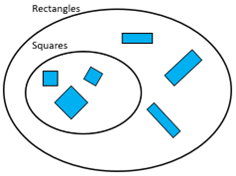
Some students may believe their shape belongs in the ellipses. Challenge them to explain why, by referring to the definitions of each shape. For example, a rhombus has four equal sides but does not need to have right-angles (actually, a square is a type of rhombus).
- Ask the students who placed rectangles and squares in the diagram to choose another shape card from the copymaster.
I want you to find someone who has a shape that is the same as your shape. All the shapes have four sides so look for a different similarity.
Look for students to find similar shapes. They might attend to:- Two pairs of parallel sides.

A four-sided polygon with two pairs of parallel sides is called a parallelogram. - One pair of parallel sides.

A four-sided polygon with only one pair of parallel sides is called a trapezium. - Two pairs of equal sides that are adjacent. Adjacent means “next to” so the equal sides meet at a corner.

A four-sided polygon that meets this criterion is called a kite. - Four equal sides.

A four-sided polygon that has all sides equal is called a rhombus. - No sides or angles that are equal.

A four-sided polygon that has unequal sides and angles is sometimes called a scalene quadrilateral.
- Two pairs of parallel sides.
- Students may notice common properties shared between shapes that are not listed above. For example, they might notice symmetry or attend to the size of one angle. They might look for similar side lengths.
Group the shapes by the properties listed in 6 as much as possible and create labels for the class of shapes and criteria for inclusion on the back of each card.
- Provoke students to think about relationships between classes of quadrilaterals. At this level it is not expected that students can create a complete Venn diagram of all the classes of quadrilateral. However, they should be able to identify if a given shape belongs or does not belong to a class. They should be exposed to creating Venn diagrams for inclusion relationships, as shown below.
- Let’s look at the squares and rhombuses (rhombi). Is a square a kind of rhombus?
Students might agree that all the squares are rhombuses because they all have equal sides. The converse is not true. A rhombus does not need to have four right angles.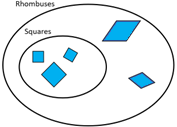
- Let’s look at the rectangles, including the squares. Is a rectangle a type of parallelogram?
All rectangles have parallel sides. However, parallelograms need not have right-angled corners so not all parallelograms are rectangles.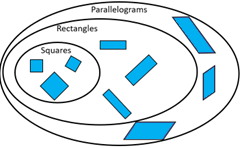
- Let’s look at the parallelograms and trapeziums. Is a trapezium a type of parallelogram?
Parallelograms have two pairs of parallel sides, but trapeziums (trapezia) have only one pair. Therefore, a trapezium is not a parallelogram and vice versa.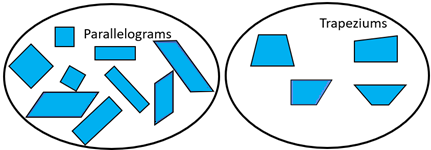
Next steps
- Ask students to classify triangles. You start by giving them a 5 x 5 pin Geoboard template and ask students to draw as many different triangles as possible. The triangles can be cut out and sorted by properties such as:
- All three sides and angles equal (equilateral triangles)
- Only two sides equal (isosceles triangles)
- A right angle (right-angled triangles)
- An angle greater that a right angle (obtuse triangles)
- No sides or angles equal (scalene triangles)
- Classify other things by their properties. Examples might be:
- Grocery items (food/not food, location in house, regularity of replacement, etc.)
- Plastic animals (habitat, food, size, colour, skin type, etc.)
- Leaves (size, shape, height above ground level, etc.)
Attachments
quadrilaterals.pdf101.71 KB
Add to plan
Level Two